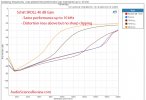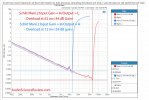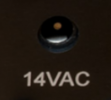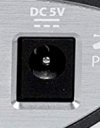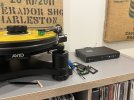With my Denon 103 (MC) and Schiit SOL, using rca cables to SKOL I do not use a grounding wire. No hum or anything.Ended up purchasing some 5-pin DIN to balanced XLR for my TT (Technics SL-1210 Mk2 with Jelco SA-250 + Hana ML). Yes, they were expensive but wanted to go full XLR for my phono chain.
BJC states: "For the less usual situation where you're running out of a turntable DIN into XLR inputs, our recommendation is Canare MS203-2BS, a two-pair cable with shielding both on the two pairs and on the whole bundle; we telescope the overall shield, tying it only to the DIN end, and ground the pair shields to the same pin at the DIN end as well as to pin 1 of the XLR output. You shouldn't ordinarily need an additional grounding wire with this configuration, so we've left it off."
I plugged them in and noticed a very slight hum at 40dB gain. At 50dB+ gain, it's a massive ground hum. Are these wired to assume there's another ground inside the tonearm to the TT chassis or something? I noticed there are other (and absurdly expensive) 5-pin DIN to XLR that DO have a ground wire, so wasn't sure what the deal is with the BJC cables.
This ground hum was not there with my old RCA din cable (BJC MSA-1) with ground wire, so I reverted back to that and it sounds fine, so I'll just keep using that. Just curious if anyone has any insight to the ground issue using a 5-pin DIN with those BJC XLR cables.
-
Welcome to ASR. There are many reviews of audio hardware and expert members to help answer your questions. Click here to have your audio equipment measured for free!
- Forums
- Audio, Audio, Audio!
- Amplifiers, Phono preamp, and Analog Audio Review
- Turntables, Phono Amplifier, Cartridges Review
You are using an out of date browser. It may not display this or other websites correctly.
You should upgrade or use an alternative browser.
You should upgrade or use an alternative browser.
Schiit Skoll Balanced Phono Stage Review
- Thread starter amirm
- Start date
It does just leave out the high pass filter and you are flat to below 20 hz. If you have low frequency noise it is unlikely you'd hear any musical information anyway.The low note on an 88 key piano is at 27 Hz, if I am correct. I think that it would be worth it to have an FR that extends at least to there.
It does just leave out the high pass filter and you are flat to below 20 hz. If you have low frequency noise it is unlikely you'd hear any musical information anyway.
Frequency Response, Normal (left) and 15 Hz filter (right), Apt Holman Preamplifier.
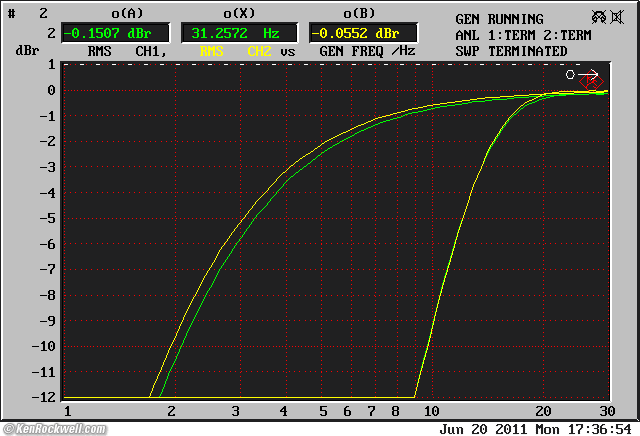
The 15 Hz filter is selected with a rear-panel switch.
It's -1/2 dB at 20 Hz, -1 dB at 17.5 Hz, -2 dB at 15 Hz, -3 dB at 14 Hz, - 5 dB at 12 Hz and -10 dB at 10 Hz.
That does the trick & allows you to have the whole 20 Hz-20KHz (unless you are looking for the low note on some organs, you are good with this setup).
Last edited:
So far, Schiit has not acknowledged this as a problem. It's just a byproduct of their new discreet topology. I think if you were to get a response from Jason, the president of Schiit, he would say that the issue is minor enough were the people that are complaining about it are suffering from "audio nervousa". In my eyes the folks he's targeting with this new better, more expensive product care about these "minor" issues, so they should look into a different board layout. I doubt we will ever hear anything from Schiit on the topic, however. Most likely they would sneak a fix into Skoll v2 whenever that comes out.Somebody knows some news / Schiit feedback about the left channel noise in Skol?
It seems something more general than one unit problem.
scottdavis0801
New Member
- Joined
- Dec 3, 2022
- Messages
- 2
- Likes
- 1
Sounding very fluid to me. Lots of slam and warmth. You can hear the flavors of the instruments, with lots of detail. I'm impressed. And that's not easy to do!!
Sounding very fluid to me. Lots of slam and warmth. You can hear the flavors of the instruments, with lots of detail. I'm impressed. And that's not easy to do!!
Only tell me the brand of what you consume
I am wondering if the left channel (internally) is closer to the AC input rectified to DC section on the circuit board. If so, there may not be much you can do about it. One thing to try - add a grounded metal shield between power supply and input relays. That could possibly reduce coupling.
View attachment 325833
This is what can be found in a Reddit thread about exactly this issue.
Link to Reddit
User jaxtherogue wrote:
I reached out to Schiit support and after going through some troubleshooting steps I ended up with this response from them:
>This isn't an issue, this is physics. The hum in the left channel is a few db higher because of its location on the board. The left channel is further away from the input, which allows it to pick up more interference. The best way to mitigate this problem is to have short, well-shielded cables. Some hum, in this case, is inevitable.
The buzz I am hearing is only at quite loud volumes which I don't normally listen to and, even in quiet passages it does not seem to be occuring during playback ?! So for me, this is not a huge deal- but if you are getting the buzz at even low volumes I would follow up with them.
They also shared this troubleshooting guide: https://www.schiit.com/guides/phono-problems
Also for the record, I have pretty good well shielded cables (Blue Jeans LC1 and Blue Jeans 1800F Balanced).
I will do some basic measurements with the Skoll today. Maybe, if I'd like a void warranty, I try a shielding cage over the PS or left channel in the future.
Last edited:
I did a basic measurement of my Skoll and it looks not optimal, to say the least. Fully Balanced in and output should make this look much better (I did use the XLR output of my RME ADI DAC, but I had to use a RCA adaptor for a cheap Behringer Interface.)
So also take Distortion with a big grain of salt, because 200 Ohms output of the RME...
I should also mention, that with keeping the interconnects as far away as possible from the PS cable, I did gain like 4 db less hum.
Subjectively I do like the Skoll very much. Using headphones, the hum is barely audible between tracks or in quiet passages.
500 µV input from REW Generator and 50 db Gain:

So also take Distortion with a big grain of salt, because 200 Ohms output of the RME...
I should also mention, that with keeping the interconnects as far away as possible from the PS cable, I did gain like 4 db less hum.
Subjectively I do like the Skoll very much. Using headphones, the hum is barely audible between tracks or in quiet passages.
500 µV input from REW Generator and 50 db Gain:
Last edited:
Digital1955
Member
- Joined
- Feb 26, 2022
- Messages
- 73
- Likes
- 63
I did a basic measurement of my Skoll and it looks not optimal, to say the least. Fully Balanced in and output should make this look much better (I did use the XLR output of my RME ADI DAC, but I had to use a RCA adaptor for a cheap Behringer Interface.)
So also take Distortion with a big grain of salt, because 200 Ohms output of the RME...
I should also mention, that with keeping the interconnects as far away as possible from the PS cable, I did gain like 4 db less hum.
Subjectively I do like the Skoll very much. Using headphones, the hum is barely audible between tracks or in quiet passages.
500 µV input from REW Generator and 50 db Gain:
I don't know if you were simulating your normal setup i.e. a 0.5 mV MC cartridge, and 50dB of gain, but sheesh in this scenario, that 100 Hz harmonic looks like its only 16 dB down from the 1Khz tone. This thing would be humming your face off listening through headphones.
I don't know if you were simulating your normal setup i.e. a 0.5 mV MC cartridge, and 50dB of gain, but sheesh in this scenario, that 100 Hz harmonic looks like its only 16 dB down from the 1Khz tone. This thing would be humming your face off listening through headphones.
Yeah, that could not have been, It was a grounding issue caused by the XLR adaptors (Pin 1, 3 and shield connected). Rushed it and didn't gave it another thought. Here is a far better one, where the 60Hz noise is even on both channels. So it really depends much upon placement and cable length, etc.
Why the distortion is quite high, I don't really know. I think still, because of mismatched impedance, Using 47k input will not make it better though. Maybe some more experienced home-brew measurements user may have an answer.
Daviede
Member
Digital1955
Member
- Joined
- Feb 26, 2022
- Messages
- 73
- Likes
- 63
I am not very clear about this, can any kind-hearted person tell me:I don't quite understand this picture, doesn't it mean high distortion? Can it be accepted at -20DB?
This simulation demonstrates a record defect characterized by pops and clicks. Typically, the highest normal playback levels are 20 mV and below. However, a pop can significantly increase these levels, resembling a pulse that spans a wide range of frequencies. Although normal playback does not occur at these elevated levels, the test evaluates how the preamp manages overload in relation to frequency, albeit momentarily as the defect is played.
I personally prefer to see the THD+N (Total Harmonic Distortion + Noise) continue to decrease all the way through at least the 50mV level. It indicates that the click and pop won't cause noticeable distortion as they occur. In this regard, the Schiit Mani 2 performs better. However when the Mani 2 hits it's limit around 65 mV, you see distortion rises quickly, whereas it doesn't on the Skoll.
Digital1955
Member
- Joined
- Feb 26, 2022
- Messages
- 73
- Likes
- 63
Why the distortion is quite high, I don't really know. I think still, because of mismatched impedance, Using 47k input will not make it better though. Maybe some more experienced home-brew measurements user may have an answer.
Start by bench marking your test setup without the phono amp by going straight from the DAC (signal generator) to the ADC input.
Daviede
Member
hello
I would like to ask about the parameter diagram of this phono preamplifier. Does his headroom not have a higher clipping point as the rated voltage of the product design increases? For example, the Clipping point for 24V power supply is generally higher than that for 12V power supply, right?
I would like to ask about the parameter diagram of this phono preamplifier. Does his headroom not have a higher clipping point as the rated voltage of the product design increases? For example, the Clipping point for 24V power supply is generally higher than that for 12V power supply, right?
Daviede
Member
Or 5V and 14V
Pyxi Phono Stage by SOTA:https://www.audiosciencereview.com/forum/index.php?threads/sota-pyxi-phono-stage-review.45076/
ifi Zen Phono pre-amp:https://www.audiosciencereview.com/forum/index.php?threads/ifi-zen-phono-review-phono-stage.35240/
Pyxi Phono Stage by SOTA:https://www.audiosciencereview.com/forum/index.php?threads/sota-pyxi-phono-stage-review.45076/
ifi Zen Phono pre-amp:https://www.audiosciencereview.com/forum/index.php?threads/ifi-zen-phono-review-phono-stage.35240/
Attachments
Skeeter
Member
If you want those notes, as the linked article says, then just switch the HPF T/O frequency from 45 Hz to 20 Hz. I listen to a lot of classical music, and unless it's organ music or something esoteric, I don't miss much below 40 Hz.
Separately, there's also this to consider when thinking about stuff below 40 Hz (via Quora)

Separately, there's also this to consider when thinking about stuff below 40 Hz (via Quora)
I did that like 2 years ago and had no distortion and around -100 dB noise floor with dithering. BUT I got a new PC since and it seems to originate (the high distortion) from my new hardware. I guess a better interface like a Focusrite would be in order, and/or play with grounding options.Start by bench marking your test setup without the phono amp by going straight from the DAC (signal generator) to the ADC input.
ChrisMag2099
Member
Yeah, that could not have been, It was a grounding issue caused by the XLR adaptors (Pin 1, 3 and shield connected). Rushed it and didn't gave it another thought. Here is a far better one, where the 60Hz noise is even on both channels. So it really depends much upon placement and cable length, etc.
Why the distortion is quite high, I don't really know. I think still, because of mismatched impedance, Using 47k input will not make it better though. Maybe some more experienced home-brew measurements user may have an answer.
View attachment 356441
Sorry for my late comment, but I'll add my thoughts. I own several phono amps, including a PS Audio Nuwave, ART Phono Phono Plus USB, A Skoll and a Mola Mola Lupe.
The Skoll is definitely sensitive to cable routing. In my environment, it's also very sensitive to cable shielding, at least on the XLR input. I have multiple DIN to XLR cables and multiple arms which use them. DIN to XLR is noise free into the Mola Mola, and my recently-sold VAC Renaissance, but with the Skoll, I've stopped trying to use it. I get radio station demodulation on the XLR in which doesn't occur on the RCA input (this was true with 2 different Skolls and both a BJC and Cardas DIN to XLR cable). If I take it to a friend's house in a residential area of Vancouver, WA, no issues.
Overall, I really like the Skoll. It's the perfect office phono amp for me due to the sound, size and price. I can live without using the XLR input.
Attachments
Digital1955
Member
- Joined
- Feb 26, 2022
- Messages
- 73
- Likes
- 63
I get radio station demodulation on the XLR in which doesn't occur on the RCA input
This interference is likely from an AM broadcast station. To address this, you can use ferrite "chokes" to reduce the interference. Opt for a ferrite mix that operates in the medium frequency range, typically 300 kHz to 3 MHz, such as Fair Rite #31. A single snap-on ferrite might not offer enough RF resistance, especially if the interference is high. Consider using a toroid (donut-shaped) and make multiple turns through it for better results.
It's worth noting that while it's unusual to encounter RF interference on the balanced connection and not the unbalanced one, it's still solvable with proper measures. Even though these devices may have some built-in RF filtering, external wiring length and proximity to a radio station can overwhelm them. That's where ferrite chokes come in handy.
Similar threads
- Poll
- Replies
- 180
- Views
- 35K
- Replies
- 43
- Views
- 6K
- Poll
- Replies
- 259
- Views
- 21K
- Poll
- Replies
- 780
- Views
- 148K
- Poll
- Replies
- 43
- Views
- 12K

